.
Monday the kids made rockets out of film cans and powered by carbon dioxide gas bubbles from Alka-Seltzer tablets.
They tried different designs for their rockets, with and without fins and nose cones and other changes.
The nose cones were made from semicircles decorated with the deep space image from the Hubble telescope.
We thought it might motivate our rockets to go as far as they possibly can.
If you want to know more about the image you can click here but be sure to come back for more about our camp.
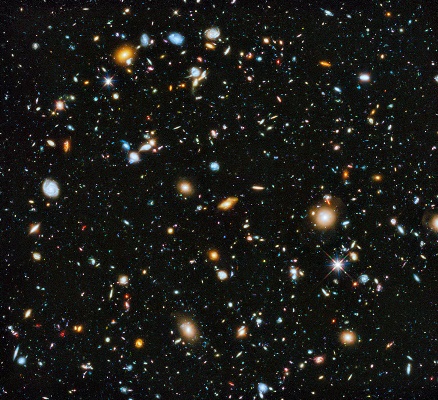
The rockets with fins didn't go as high as others probably because of the added weight.
Maximum altitude was more than 10 feet (3 meters).
Another of the projects was a different rocket design.
These were made from pool noodles with a rubber band secured to the nose and streamers attached to the back.
Neither these nor the film cans are true rockets since they have only an initial impulse as they start and no thrust from reaction to mass discharged during flight.
But it would be correct to call them ballistic missiles.
The second and third pictures show the missiles in flight near the upper left corners.
The campers all tried their hand at measuring the height of the auditorium ceiling.
Each kid positioned themselves so that their line of sight was exactly 45 degrees up to a light.
Then we measured the horizontal distance from a point directly under that light to their eye and the height of their eye above the floor.
The sum of those two numbers is the ceiling height.
This diagram may be easier to understand.
Because we selected 45 degrees as the sight angle the red Horizontal Distance line, that we measured, is the same length as the brown HD line.
The greenish EH line is the same as the Eye Height, that we measured, because the horizontal distance line is parallel to the floor.
So the sum of the lengths of the HD and EH lines is the height of the light and therefore the ceiling.
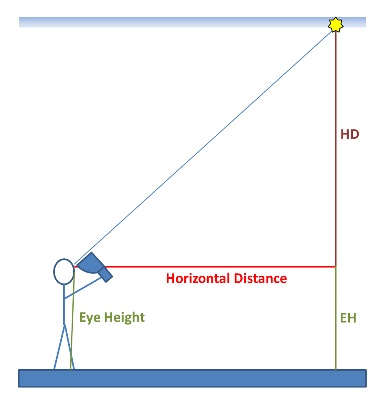
The results ranged from 16 to 18 feet with a couple very close to the average.
We used the gage again later in the week to measure how high our water rockets went.
Here is the gage we used.
Note the sights at the ends of the 90 degree line.
Other projects Monday included a Brain Hemisphere Hat.
It shows names for some parts of the brain and what sort of activity is associated with each.
Make one , put it on, and think.
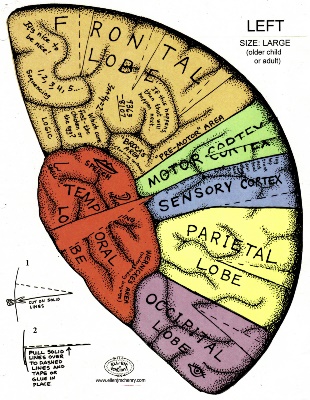
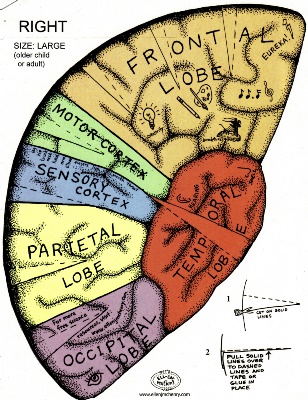
The instructions are here.
And they silk screened the front of their camp t-shirts learning a graphics art technique.
On the back was this design.

Tuesday we talked about the early balloon scientists, the challenges they faced, the dangers involved, and what it is like to fly in one.
Then each of the kids built and flew their own hot air balloon.
It was windy so all the adults were needed to help manage the balloon inflations so there aren't any pictures of that operation.
We were fortunate that even with the wind we didn't set any on fire though some got scorched.
Because of the wind a couple of them pulled loose from their tethering cord and landed on power lines.
Both eventually blew free and were recovered.
If you would like to make and fly a balloon yourself the instructions are here.
After the balloon flights we studied the densities of some solids and liquids.
These blocks of different materials all have the same mass.
The small ones are much more dense than the largest.
The blocks in the top row are all less dense than water. They are oak, pine, lithium metal (simulated), and balsa.
The bottom row will all sink. They are lead, copper, brass, zinc, iron, aluminum, carbon, and lignum vitae (a kind of wood).
They liked the rock (volcanic pumice) that floated and wood (lignum vitae) that sank in water.
We challenged the campers to build a boat out of a square of aluminum foil that would float holding as many marbles as possible.
Some resembled canoes, others barges or bowls,
The kids put their boat in a basin of water and started adding marbles.
We put them in a line in order of cargo capacity.
Then they each built another boat incorporating what they had figured out from the results of the first set.
The second set was much improved.
We then had a discussion about factors other than cargo capacity that need to be considered by boat designers.
Things like cost, power source, waves, weather, crew, passengers and many more factors were suggested.
We also built Cartesian Divers.
The campers used short sections of drinking straws.
They used modeling clay to close one end so that air couldn't escape (that will be the top of our diver).
The bottom end was weighted with more clay so that it would float upright in the water.
They used a basin of water to test the diver's buoyancy as they adjusted the amount of clay at the bottom .
When it is right the diver will just barely float.
Put the diver in a plastic bottle nearly full of water and secure the lid.
Squeeze the bottle and the diver will descend, release the pressure and it will rise to the top.
Wednesday we met at the Laurel Gorge to study fossils and the geology, flora and fauna found there.
The kids were fascinated and some more than a little repulsed by a dinosaur coprolite (fossil poop).
Each of our campers took home a plaster replica of these Brachiopods
And this Pterodactyl fossil
They also got to select a real fossil from the limestone layer that underlies the sandstone cliffs of the gorge.
Most selected a segment of a crinoid stem.
An intact crinoid looks like this.
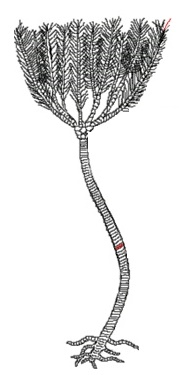
We didn't find any dinosaur fossils because the rocks here are too old.
They looked at the mix of dinosaur and bird features in this replica of an archeopterix fossil.
We also made a plaster cast of a print in the mud near the spring next to the trail.
Thursday the campers built and launched water bottle rockets.
and measured the altitude they reached using the angle gage we practiced with on Monday.
Videos of three of the launches, each at normal speed and then slowed by a factor of eight.
